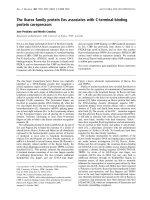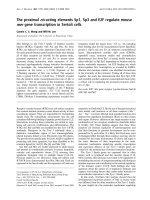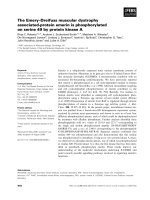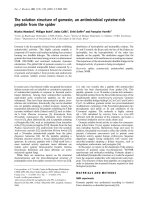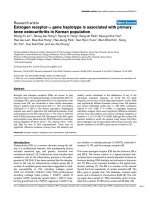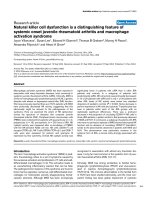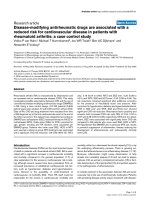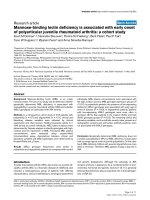Báo cáo y học: "The PTPN22 1858C/T polymorphism is associated with anti-cyclic citrullinated peptide antibody-positive early rheumatoid arthritis in northern Sweden" pdf
Bạn đang xem bản rút gọn của tài liệu. Xem và tải ngay bản đầy đủ của tài liệu tại đây (154.74 KB, 7 trang )
Open Access
Available online />Page 1 of 7
(page number not for citation purposes)
Vol 9 No 3
Research article
The PTPN22 1858C/T polymorphism is associated with anti-cyclic
citrullinated peptide antibody-positive early rheumatoid arthritis
in northern Sweden
Heidi Kokkonen
1
, Martin Johansson
1
, Lena Innala
1
, Erik Jidell
2
and Solbritt Rantapää-Dahlqvist
1
1
Department of Rheumatology, University Hospital, SE-901 85 Umeå, Sweden
2
Department of Transfusion Medicine, University Hospital, SE-901 85 Umeå, Sweden
Corresponding author: Solbritt Rantapää-Dahlqvist,
Received: 30 Jan 2007 Revisions requested: 19 Mar 2007 Revisions received: 10 May 2007 Accepted: 6 Jun 2007 Published: 6 Jun 2007
Arthritis Research & Therapy 2007, 9:R56 (doi:10.1186/ar2214)
This article is online at: />© 2007 Kokkonen et al.; licensee BioMed Central Ltd.
This is an open access article distributed under the terms of the Creative Commons Attribution License ( />),
which permits unrestricted use, distribution, and reproduction in any medium, provided the original work is properly cited.
Abstract
The PTPN22 1858C/T polymorphism has been associated with
several autoimmune diseases including rheumatoid arthritis
(RA). We have shown that carriage of the T variant (CT or TT) of
PTPN22 in combination with anti-cyclic citrullinated peptide
(anti-CCP) antibodies highly increases the odds ratio for
developing RA. In the present study we analysed the association
between the PTPN22 1858C/T polymorphism and early RA in
patients from northern Sweden, related the polymorphism to
autoantibodies and the HLA-DR shared epitope, and analysed
their association with markers for disease activity and
progression. The inception cohort includes individuals who also
donated samples before disease onset. A case–control study
was performed in patients (n = 505; 342 females and 163
males) with early RA (mean duration of symptoms = 6.3 months)
and in population-based matched controls (n = 970) from
northern Sweden. Genotyping of the PTPN22 1858C/T
polymorphism was performed using a TaqMan instrument. HLA-
shared epitope alleles were identified using PCR sequence-
specific primers. Anti-CCP2 antibodies were determined using
enzyme-linked immunoassays. Disease activity (that is, the
number of swollen and tender joints, the global visual analogue
scale, and the erythrocyte sedimentation rate) was followed on
a regular basis (that is, at baseline and after 6, 12, 18 and 24
months). Both the 1858T allele and the carriage of T were
associated with RA (χ
2
= 23.84, P = 0.000001, odds ratio =
1.69, 95% confidence interval = 1.36–2.11; and χ
2
= 22.68, P
= 0.000002, odds ratio = 1.79, 95% confidence interval =
1.40–2.29, respectively). Association of the 1858T variant with
RA was confined to seropositive disease. Carriage of 1858T
and the presence of anti-CCP antibodies was independently
associated with disease onset at an earlier age (P < 0.05 and P
< 0.01, respectively), while the combination of both resulted in
an even earlier age at onset. Smoking was identified as a risk
factor independent of the 1858T variant and anti-CCP
antibodies.
Introduction
Recent studies have shown that a missense single nucleotide
polymorphism resulting in a substitution of T for C at position
1858 in the protein tyrosine phosphatase nonreceptor type 22
(PTPN22) gene is associated with several autoimmune dis-
eases including rheumatoid arthritis (RA) [1-3]. Several of the
autoimmune diseases associated with the PTPN22 1858T
variant are characterized by the presence of autoantibodies.
These autoantibodies can be present several years before
onset of the disease [4-6]. We have previously shown that a
combination of the T variant of PTPN22 and anti-cyclic citrull-
inated peptide (anti-CCP) antibodies in combination strongly
predicts the future onset of RA with a specificity of 100% for
the disease [7].
The association between the PTPN22 polymorphism and RA
has been replicated by several groups studying different RA
populations [1,8-11]. The first study on PTPN22 limited its
association to rheumatoid factor-positive disease [1]. This
polymorphism has subsequently been associated with both
seropositive [8,12] and seronegative disease [13,14].
anti-CCP = anti-cyclic citrullinated peptide; CI = confidence interval; DAS28 = disease activity score; HLA = human leukocyte antigen; OR = odds
ratio; PCR = polymerase chain reaction; PTPN22 = protein tyrosine phosphatase nonreceptor type 22; RA = rheumatoid arthritis; SE = shared
epitope.
Arthritis Research & Therapy Vol 9 No 3 Kokkonen et al.
Page 2 of 7
(page number not for citation purposes)
In addition to genetic factors, environmental factors have been
proposed to be of importance in the aetiology of RA. Several
studies have suggested smoking to be the major environmen-
tal risk factor for RA [15,16]. HLA-shared epitope (SE) alleles
and smoking have also recently been shown to act synergisti-
cally as risk factors, but only in anti-CCP antibody-positive
patients with RA [17].
Considering our findings of a stronger predictive value of the
combination of PTPN22 1858T variant with anti-CCP antibod-
ies compared with HLA-SE and anti-CCP antibodies for devel-
opment of RA in individuals before disease onset [7], the aim
of the present study was to investigate the 1858 C/T polymor-
phism in relation to the presence of autoantibodies and HLA-
SE alleles in an inception cohort of RA patients from northern
Sweden for disease susceptibility, onset and inflammatory
activity during the first 2 years. The individuals with blood sam-
ples before disease onset were included in the cohort of
patients with early RA after disease onset.
Materials and methods
Patients from the four northern-most counties of Sweden with
early RA (duration of symptoms < 12 months) were consecu-
tively included in the study and followed for 2 years. A total of
563 individuals fulfilling at least four of the seven American
College of Rheumatology criteria for RA [18] were identified.
The patients were assessed clinically at baseline and after 6,
12, 18 and 24 months using the 28-joint count for tender and
swollen joints and a global visual analogue scale, and the
erythrocyte sedimentation rate was measured. The Disease
Activity Score (DAS28) was calculated [19]. Of the patients
identified, 505 (342 females, 163 males) were willing to par-
ticipate and donated DNA for this study. During the study
period, 98.0% (n = 448/457) of the patients were treated for
at least 6 months with disease-modifying antirheumatic drugs
and 53.0% (n = 244/460) of the patients were receiving pred-
nisolone for at least 6 months. All patients were asked by
questionnaire about their smoking habits, and were defined as
smoker, nonsmoker ever or previous smoker. Demographic
and clinical data of the patients at baseline are presented in
Table 1.
From among the 505 patients with early RA, a subcohort of 85
individuals was identified as being donors to the Medical
Biobank of northern Sweden before disease onset. The
median time predating disease onset was 2.7 years (interquar-
tile range = 1.1–6.0 years). Serological analyses before and
after disease onset were undertaken for these individuals. The
Medical Biobank is population based, and conditions for
recruitment into the cohorts and for the collection and storage
of blood samples have previously been described in detail [5].
A total of 970 controls from the Medical Biobank of northern
Sweden were randomly selected and matched for sex and age
within a range of 5 years. The mean age of the controls was
58.2 years (range 25–79 years), and the distribution of males
and females was 26.3% and 73.7%, respectively. The
Regional Ethics Committee at the University Hospital at Umeå
approved this study and all participants gave their written
informed consent.
The DNA from patients and controls (n = 505 and n = 970,
respectively) was extracted from ethylenediamine tetraacetic
acid-treated whole blood using a standard salting-out method.
The 5' nuclease assay was used to determine the PTPN22
1858 C/T polymorphism (single nucleotide number
rs2476601) as previously described [7]. The PCRs were per-
formed according to the manufacturers' instructions, and
detection of the different genotypes was made using an ABI
PRISM
®
7900 HT Sequence Detector System (Applied Bio-
systems, Foster City, CA, USA). Data were processed using
the SDS 2.1 software (Applied Biosystems). The different
genotypes were verified by comparison with control samples
of known genotype. Genotyping was successful for 504 of the
patients.
Table 1
Clinical and demographic data of the rheumatoid arthritis patients at baseline
Patients (n = 505) Controls (n = 970)
Age (years) 54.5 ± 14.0 57.4 ± 11.6
Sex (females/males) 342/163 (67.7/32.3) 705/265 (72.7/27.3)
Symptom duration (months) 6.3 ± 2.8
Prednisolone treatment (number receving prednisolone/total number of patients) 195/456 (42.8)
Disease-modifying antirheumatic drug treatment (number receving DMARD/total number of patients) 348/403 (86.4)
Smoking ever (current, past), (number ever smoking/total number of patients) 321/492 (65.2) 242/899 (26.9)
Anti-cyclic citrullinated peptide antibody-positive (number anti-CCP ab positive/total number of patients) 318/468 (67.9) 5/347 (1.4)
Rheumatoid factor-positive (number RF positive/total number of patients) 264/366 (72.1)
Data presented as the mean ± standard deviation or number ratio (percentage).
Available online />Page 3 of 7
(page number not for citation purposes)
HLA-DRB1 genotyping was performed using PCR sequence-
specific primers from the DR low-resolution kit and DRB1*04
subtyping kits (Olerup SSP AB, Saltsjöbaden, Sweden)
according to the previously described method [20]. The HLA-
SE genes were defined as DRB1*0404 and DRB1*0401.
Results of HLA-DRB1 genotyping were available for 500
patients and 170 randomly selected controls (mean age 53.0
± 8.9 years, 74.7% females and 25.3% males).
Anti-CCP2 antibodies (n = 468 patients) were determined
using the Diastat kit from Axis-Shield Diagnostics (Dundee,
UK) (cutoff value = 5 units/ml). Rheumatoid factor of the IgM
isotype was determined using the agglutination test with sen-
tized sheep erythrocytes as originally described according to
Waaler-Rose (n = 366).
The chi-square test was used for testing categorical data
between groups. Student's t-test for independent samples
was used to analyse continuous data. Binary logistic regres-
sion models were used to estimate predictive values of the
1858T variant of PTPN22, HLA-SE alleles, anti-CCP antibod-
ies and smoking. Odds ratios (ORs) were calculated with 95%
confidence intervals (CIs). All P values refer to a two-sided
test, and P ≤ 0.05 was considered statistically significant. To
correct for multiple comparisons, a corrected P value (P
c
) is
also presented. The calculations were performed using the
SPSS package (SPSS for Windows 14.0; SPSS Inc., Chi-
cago, IL, USA). The area under the curve using DAS28 values
for 24 months was calculated. Any missing values were
assumed to be at random; consequently, the last value forward
was used for missing DAS28 values at specific time points.
Results
The genotype distribution of the PTPN22 1858C/T polymor-
phism was in Hardy–Weinberg equilibrium in both the patient
group and the control group. The genotype distributions dif-
fered significantly between patients and controls (χ
2
= 23.85,
P = 0.000007). The 1858T allele of PTPN22 was significantly
higher in patients compared with controls, being 18.0% ver-
sus 11.4%, respectively (χ
2
= 23.84, 2 degrees of freedom, P
= 0.000001, P
c
= 0.000005, OR = 1.69, 95% CI = 1.36–
2.11). The CT and TT genotypes were present in 33.0% of the
patients and in 21.5% of the controls (χ
2
= 22.68, P =
0.000002, P
c
= 0.00001, OR = 1.79, 95% CI = 1.40–2.29).
The CC genotype was significantly decreased in patients
compared with controls, at 67.1% versus 78.5%, respectively
(χ
2
= 22.68, P = 0.000002, P
c
= 0.00001, OR = 0.56, 95%
CI = 0.44–0.72) (Table 2).
When the patients were stratified according to autoantibody
Table 2
Frequency distribution of the 1858 C/T polymorphism of PTPN22 in patients with early rheumatoid arthritis and matched controls
Genotype Patients (n = 504) Controls (n = 970) χ
2
P value P
c
value Odds ratio 95% confidence interval
n % n %
CC 338 67.1 761 78.5 22.68 0.000002 0.00001 0.56 0.44–0.72
CT 151 30.0 196 20.2 17.53 0.000028 0.00014 1.69 1.31–2.18
TT 15 3.0 13 1.3 4.76 0.02907 0.14535 2.26 1.01–5.08
CT + TT 166 33.0 209 21.5 22.68 0.000002 0.00001 1.79 1.40–2.29
T allele 181 18.0 222 11.4 23.84 0.000001 0.000005 1.69 1.36–2.11
P
c
, corrected P value.
Table 3
Comparison of PTPN22 1858 genotypes in rheumatoid arthritis patients stratified according to anti-cyclic citrullinated peptide (anti-
CCP) antibodies and rheumatoid factor with all controls
CT + TT
genotype, n (%)
CC genotype, n (%) Minor allele
frequency
Cases versus all controls
a
χ
2
P value P
c
value Odds ratio 95% confidence interval
Anti-CCP antibody-positive 113 (35.5) 205 (64.5) 0.196 24.99 0.0000006 0.0000024 2.01 1.51–2.67
Anti-CCP antibody-negative 40 (26.7) 110 (73.3) 0.145 1.97 0.16046 0.64184 1.32 0.88–2.00
Rheumatoid factor-positive 96 (36.4) 168 (63.6) 0.199 24.49 0.0000007 0.0000028 2.08 1.53–2.82
Rheumatoid factor-negative 28 (27.5) 74 (72.5) 0.142 1.87 0.17164 0.68656 1.38 0.85–2.23
P
c
, corrected P value.
a
Controls presented in Table 2
Arthritis Research & Therapy Vol 9 No 3 Kokkonen et al.
Page 4 of 7
(page number not for citation purposes)
status, the risk for RA in patients carrying the 1858T variant
was confined to those seropositive for anti-CCP antibodies or
rheumatoid factor (P = 0.0000006, P
c
= 0.0000024 and P =
0.0000007, P
c
= 0.0000028, respectively) compared with
controls (Table 3). In patients seronegative for these autoanti-
bodies, carriage of the 1858T variant did not increase the risk
for RA (P = 0.16 and P = 0.17, respectively) compared with
controls. There were no significant differences in genotype
distributions (P = 0.14 and P = 0.16) or T-allele frequencies
(P = 0.16 and P = 0.17) in patients positive for compared with
patients negative for anti-CCP antibodies or rheumatoid
factors.
No significant difference in disease activity (DAS28) calcu-
lated by the area under the curve using DAS28 values for 24
months was detected between 1858T carriers and noncarri-
ers (P = 0.312). Carriers of the 1858T variant, however, had
significantly higher DAS at 6 months (P < 0.05, P
c
= 0.20).
Treatment of the disease at 6 months with disease-modifying
antirheumatic drugs or prednisolone was similar in patients
with or without the 1858T variant (namely, 87% and 85%,
respectively, receiving disease-modifying antirheumatic drugs;
and 41% and 44%, respectively, receiving prednisolone).
The mean age at disease onset in patients carrying the 1858T
variant (n = 166) was 3.0 years less than that in patients lack-
ing this allele (n = 338) (T carrier, 52.5 years; and non-T car-
rier, 55.5 years; P < 0.05). Patients with anti-CCP antibodies
(n = 318) had an earlier onset of the disease compared with
patients without these autoantibodies (n = 150) (53.2 years
for patients with anti-CCP antibodies and 56.8 years for
patients without anti-CCP antibodies, P < 0.01). A combina-
tion of the 1858T variant and anti-CCP antibodies contributed
to an even earlier age of disease onset (1858T + anti-CCP
antibodies, 51.5 years; compared with 55.2 years for those
without this combination; P < 0.05).
The HLA-SE alleles were present in 282 (56.4%) of the
patients and in 66 (38.8%) of the controls. There was a weak
significant association of HLA-SE with the 1858T variant of
PTPN22 (χ
2
= 4.40, P = 0.036), with a concordance rate of
52%. The OR for RA in individuals with HLA-SE was 2.04
(95% CI = 1.43–2.91). Carriage of HLA-SE was significantly
associated with the presence of anti-CCP antibodies (χ
2
=
35.54, P < 0.0001).
Anti-CCP antibodies were the strongest risk factor for devel-
opment of RA in simple logistic regression analyses of the
PTPN22 1858T variant, HLA-SE allele, anti-CCP antibodies
and smoking, whereas the other risk factors had a rather simi-
lar OR for RA (Table 4).
Simple logistic regression analyses of the 1858T variant, HLA-
SE and smoking after stratification for anti-CCP antibodies
Table 4
Simple logistic regression analyses determining the odds ratios for different risk factors for rheumatoid arthritis
Odds ratio 95% confidence interval
Anti-cyclic citrullinated peptide antibodies 145.00 58.72–358.09
Smoking 5.10 4.02–6.46
HLA-shared epitope 2.04 1.43–2.91
T-carriage 1.79 1.41–2.28
Table 5
Relative risk for developing rheumatoid arthritis in patients, stratified for anti-cyclic citrullinated peptide (anti-CCP) antibodies
Non-T carrier (CC) T carrier (CT, TT)
Cases/controls Relative risk (95% confidence interval) Cases/controls Relative risk (95% confidence interval)
Anti-CCP antibody-positive
Smoking-negative 59/511 1.00 37/146 2.17 (1.41–3.35)
Smoking-positive 142/192 6.29 (4.51–8.77) 73/50 12.54 (8.11–19.40)
Anti-CCP antibody-negative
Smoking-negative 47/511 1.00 17/146 1.36 (0.80–2.33)
Smoking-positive 60/192 3.71 (2.51–5.46) 23/50 5.87 (3.46–9.95)
The combination of carriage or not of the 1858T variant of the PTPN22 gene and ever or never smoking were compared for groups stratified for
anti-CCP antibodies.
Available online />Page 5 of 7
(page number not for citation purposes)
showed that smoking was a risk factor for RA in both the anti-
CCPantibody seropositive group and the anti-CCP antibody-
seronegative group (OR = 6.15, 95% CI = 4.68–8.07 and OR
= 3.51, 95% CI = 2.46–5.01, respectively). The 1858T variant
and HLA-SE were risk factors for RA only in the anti-CCP anti-
body-positive group (OR = 2.00, 95% CI = 1.52–2.65 and
OR = 3.11, 95% CI = 2.11–4.58, respectively). In multiple
regression analysis stratified for anti-CCP antibody and with
RA as the dependent variable, the ORs were fairly equal for
smoking (OR = 2.64, 95% CI = 1.71–4.08), for HLA-SE (OR
= 3.34, 95% CI = 2.18–5.15) and for carriage of the 1858T
variant (OR = 2.57, 95% CI = 1.54–4.29) in anti-CCP anti-
body-positive patients. In anti-CCP antibody-negative patients
none of the variables remained significant.
Smoking was a risk factor for RA independent of anti-CCP
antibodies and carriage of 1858T in analyses with different
combinations of anti-CCP antibodies, carriage of the T allele
and smoking compared with nonsmokers without the 1858T
variant (Table 5). HLA-SE was a risk factor for RA only in anti-
CCP antibody-positive patients; the relative risk of which was
further increased in smokers compared with nonsmokers with-
out HLA-SE (Table 6).
To analyse the relationship of different factors to anti-CCP
antibodies as the dependent variable, multiple logistic regres-
sion analysis was performed with the variables 1858T variant,
HLA-SE allele and smoking. The 1858T variant was not found
to be significant (OR = 1.42 95% CI = 0.90–2.23). Both
smoking and HLA-SE predicted significantly the presence of
anti-CCP antibodies, with the strongest impact from HLA-SE
(OR = 1.69, 95% CI = 1.11–2.57 and OR = 3.25, 95% CI =
2.15–4.92, respectively).
There was no difference in the levels of anti-CCP antibodies in
patients with or without the 1858T variant or carrying HLA-SE.
In the subcohort of individuals for whom samples were availa-
ble before disease onset (n = 85), anti-CCP antibodies were
present in 32.1%. Among those who lacked anti-CCP anti-
bodies before disease onset but who turned anti-CCP anti-
body positive at disease onset, 62.5% were HLA-SE positive
while 40% were HLA-SE negative (not significant). There was
no relationship between carriage of the T variant and develop-
ing anti-CCP antibodies at disease onset compared with not
carrying the T variant (51.4% versus 52.4%, respectively).
Discussion
In the present study, an association of the 1858T allele of
PTPN22 with RA was found in 505 individuals from the four
northern-most counties of Sweden with early RA,. In agree-
ment with a study from southern Sweden and also other stud-
ies, this association was confined to patients with seropositive
disease [1,8,12].
Both the 1858T variant and HLA-SE alleles predicted RA, with
an increase of the relative risk of each when present in combi-
nation with anti-CCP antibodies. This was also found in indi-
viduals who subsequently developed RA [7,20]. In the present
study, in patients with early RA (that is, after disease onset),
there was no significant association between the 1858T vari-
ant and anti-CCP antibodies, whereas HLA-SE was strongly
associated with anti-CCP antibodies. The increase in the
number of anti-CCP antibody-positive patients after disease
onset was greater among those carrying HLA-SE alleles. This
was evaluated in a subcohort of individuals who were anti-
CCP-negative prior to onset of symptoms of disease but who
became seropositive after disease onset; however, the
number of individuals concerned was small and the difference
did not reach statistical significance. These results could sug-
gest that the 1858T variant is important before the disease has
developed to a clinical stage, whereas HLA-SE is of significant
importance when the disease has developed. Both these and
our previous studies confirm that anti-CCP antibodies are the
major predictor for RA. Taken together, these results could
indicate that both genes contribute to the development of a
disease, such as RA, by interfering in separate ways or at sep-
arate stages of pathogenesis (for example, by acting at various
levels in the immunological process leading to the develop-
Table 6
Relative risk for developing rheumatoid arthritis in patients, stratified for anti-cyclic citrullinated peptide (anti-CCP) antibodies
Nonsmoking Smoking
Cases/controls Relative risk (95% confidence interval) Cases/controls Relative risk (95% confidence interval)
Anti-CCP antibody-positive
HLA-shared epitope-positive 33/41 1.00 71/49 1.67 (0.95–2.94)
HLA-shared epitope-negative 62/33 2.05 (1.12–3.75) 143/21 7.61 (4.05–14.30)
Anti-CCP antibody-negative
HLA-shared epitope-positive 40/41 1.00 52/49 1.11 (0.63–1.95)
HLA-shared epitope-negative 23/33 0.71 (0.37–1.38) 31/21 1.92 (0.98–3.77)
The combination of carriage of HLA-shared epitope alleles or not, and ever or never smoking were compared for groups stratified for anti-CCP
antibodies.
Arthritis Research & Therapy Vol 9 No 3 Kokkonen et al.
Page 6 of 7
(page number not for citation purposes)
ment of a disease). HLA-SE is believed to be involved in the
antigen-presenting process whereas the role of the PTPN22
polymorphism for various parts of the immune system is not yet
clear. The PTPN22 polymorphism is associated with several
other autoimmune diseases, while HLA-SE is strongly related
only to RA.
In contrast to most previous studies, we found that the
PTPN22 1858T variant and HLA-SE are significantly associ-
ated [8,10,12,14,21]. One study has observed an association
of the PTPN22 1858T variant and HLA-SE, but this was
restricted to male patients [13].
Smoking has been shown to be the major environmental risk
factor for RA [15,16]. In our study, smoking was a risk factor
for RA independent of anti-CCP antibodies and the 1858T
variant. In simple logistic regression analyses of anti-CCP anti-
body-negative patients, smoking was the only significant risk
factor for RA, but this significance was lost in multiple logistic
regression analysis. In the presence of anti-CCP antibodies,
HLA-SE was a risk factor for RA; addition of smoking
increased this risk approximately three-fold, which confirms
the results presented in a previous study [17].
The genotype and allele frequencies of the PTPN22 polymor-
phism in patients and controls were higher in our study than
those reported by some other groups [1,10,14,22]. Our
results are consistent with the previously reported increasing
south to north gradient in the frequency of the 1858T variant
in white European populations [23].
A gene-dosage effect of the 1858T allele has been suggested
because a higher susceptibility for RA was found in individuals
homozygous for the T allele [8,13]. We similarly found the OR
for homozygous carriers of the T allele to be higher than that
for heterozygous carriers (2.26 versus 1.69), suggesting a
dose effect of the T allele of PTPN22. The number of
homozygous carriers we were able to study, however, was
small (n = 15).
Little is known about the effect of 1858T on disease severity
and activity. Most studies investigating the effect of 1858T on
clinical characteristics have found no association of 1858T
with disease severity or activity [13,21,22]. To analyse the
effect of the 1858T variant on disease activity we calculated
the area under the curve using DAS28 values for 24 months,
but no significant association of 1858T with disease activity
was found. There was a significant difference in disease
activity at 6 months (P < 0.05),, when 1858T carriers had a
higher DAS28 than patients without the T variant. This differ-
ence was not due to a difference in treatment prescribed;
instead, it is possible that carriers of 1858T do not respond
primarily as well to the treatment as non-T-carriers. The statis-
tical significance did not remain, however, after correction for
the number of performed tests.
It has been shown that the 1858T variant contributes to an
earlier age at onset of the disease [12,13]. We were able to
confirm this finding; patients with the T variant were signifi-
cantly younger compared with patients not carrying the T var-
iant. The presence of anti-CCP antibodies, particularly in
combination with 1858T, contributed to an earlier age at onset
of the disease.
Conclusion
The PTPN22 1858C/T polymorphism was shown to be asso-
ciated with early RA in the northern Swedish population and
was confined to seropositive disease. Patients carrying the
1858T variant had an earlier onset of the disease, particularly
when in combination with anti-CCP antibodies. Furthermore,
we could verify a south–north gradient with high frequencies
of the PTPN22 1858 T variant in patients and controls. Smok-
ing was, in this patient cohort, a risk factor for RA independent
of the 1858T variant and seropositivity for anti-CCP
antibodies.
Competing interests
The authors declare that they have no competing interests.
Authors' contributions
HK was the main investigator, carried out the genotyping and
the statistics, and contributed to preparation of the manu-
script. MJ and LI participated in the collection of the material
and registration of the patient data. EJ was responsible for the
HLA typing. SR-D is the principal investigator, responsible for
the Biobank samples, designed the investigation, and partici-
pated in data collection, statistical analysis and drafting of the
manuscript.
Acknowledgements
This study was supported by grants from the Swedish Research Council
(K2003-74XD-14705-01), King Gustaf V's 80-Year Fund, the Swedish
Rheumatism Association, the Swedish Heart-Lung Foundation and the
Medical Faculty of Umeå University, Umeå, Sweden. The authors thank
colleagues from the Rheumatology Department at the hospitals of Sun-
derbyn, Sundsvall and Östersund. Solveig Linghult and Thord Johans-
son are gratefully acknowledged for technical assistance. The staff of
the Medical Biobank, and of the Early Arthritis Clinic, Department of
Rheumatology, University Hospital of Umeå are also gratefully
acknowledged.
References
1. Begovich AB, Carlton VE, Honigberg LA, Schrodi SJ, Chokkalin-
gam AP, Alexander HC, Ardlie KG, Huang Q, Smith AM, Spoerke
JM, et al.: A missense single-nucleotide polymorphism in a
gene encoding a protein tyrosine phosphatase (PTPN22) is
associated with rheumatoid arthritis. Am J Hum Genet 2004,
75:330-337.
2. Bottini N, Musumeci L, Alonso A, Rahmouni S, Nika K, Rostam-
khani M, MacMurray J, Meloni GF, Lucarelli P, Pellecchia M, et al.:
A functional variant of lymphoid tyrosine phosphatase is asso-
ciated with type I diabetes. Nat Genet 2004, 36:337-338.
3. Criswell LA, Pfeiffer KA, Lum RF, Gonzales B, Novitzke J, Kern M,
Moser KL, Begovich AB, Carlton VE, Li W, et al.: Analysis of fam-
ilies in the multiple autoimmune disease genetics consortium
(MADGC) collection: the PTPN22 620W allele associates with
Available online />Page 7 of 7
(page number not for citation purposes)
multiple autoimmune phenotypes. Am J Hum Genet 2005,
76:561-571.
4. Arbuckle MR, McClain MT, Rubertone MV, Scofield RH, Dennis
GJ, James JA, Harley JB: Development of autoantibodies before
the clinical onset of systemic lupus erythematosus. N Engl J
Med 2003, 349:1526-1533.
5. Rantapaa-Dahlqvist S, de Jong BA, Berglin E, Hallmans G, Wadell
G, Stenlund H, Sundin U, van Venrooij WJ: Antibodies against
cyclic citrullinated peptide and IgA rheumatoid factor predict
the development of rheumatoid arthritis. Arthritis Rheum 2003,
48:2741-2749.
6. Strieder TG, Prummel MF, Tijssen JG, Endert E, Wiersinga WM:
Risk factors for and prevalence of thyroid disorders in a cross-
sectional study among healthy female relatives of patients
with autoimmune thyroid disease. Clin Endocrinol (Oxf) 2003,
59:396-401.
7. Johansson M, Arlestig L, Hallmans G, Rantapaa-Dahlqvist S:
PTPN22 polymorphism and anti-cyclic citrullinated peptide
antibodies in combination strongly predicts future onset of
rheumatoid arthritis and has a specificity of 100% for the
disease. Arthritis Res Ther 2005, 8:R19.
8. Lee AT, Li W, Liew A, Bombardier C, Weisman M, Massarotti EM,
Kent J, Wolfe F, Begovich AB, Gregersen PK: The PTPN22
R620W polymorphism associates with RF positive rheumatoid
arthritis in a dose-dependent manner but not with HLA-SE
status. Genes Immun 2005, 6:129-133.
9. Hinks A, Barton A, John S, Bruce I, Hawkins C, Griffiths CE, Donn
R, Thomson W, Silman A, Worthington J: Association between
the PTPN22 gene and rheumatoid arthritis and juvenile idio-
pathic arthritis in a UK population: further support that
PTPN22 is an autoimmunity gene. Arthritis Rheum 2005,
52:1694-1699.
10. Orozco G, Sanchez E, Gonzalez-Gay MA, Lopez-Nevot MA, Torres
B, Caliz R, Ortego-Centeno N, Jimenez-Alonso J, Pascual-Salcedo
D, Balsa A, et al.: Association of a functional single-nucleotide
polymorphism of PTPN22, encoding lymphoid protein phos-
phatase, with rheumatoid arthritis and systemic lupus
erythematosus. Arthritis Rheum 2005, 52:219-224.
11. Zhernakova A, Eerligh P, Wijmenga C, Barrera P, Roep BO, Koe-
leman BP: Differential association of the PTPN22 coding vari-
ant with autoimmune diseases in a Dutch population. Genes
Immun 2005, 6:459-461.
12. Plenge RM, Padyukov L, Remmers EF, Purcell S, Lee AT, Karlson
EW, Wolfe F, Kastner DL, Alfredsson L, Altshuler D, et al.: Repli-
cation of putative candidate-gene associations with rheuma-
toid arthritis in >4,000 samples from North America and
Sweden: association of susceptibility with PTPN22, CTLA4,
and PADI4. Am J Hum Genet 2005, 77:1044-1060.
13. Pierer M, Kaltenhauser S, Arnold S, Wahle M, Baerwald C,
Hantzschel H, Wagner U: Association of PTPN22 1858 single-
nucleotide polymorphism with rheumatoid arthritis in a Ger-
man cohort: higher frequency of the risk allele in male com-
pared to female patients. Arthritis Res Ther 2006, 8:R75.
14. Simkins HM, Merriman ME, Highton J, Chapman PT, O'Donnell JL,
Jones PB, Gow PJ, McLean L, Pokorny V, Harrison AA, et al.:
Association of the PTPN22 locus with rheumatoid arthritis in a
New Zealand Caucasian cohort. Arthritis Rheum 2005,
52:2222-2225.
15. Silman AJ, Newman J, MacGregor AJ: Cigarette smoking
increases the risk of rheumatoid arthritis. Results from a
nationwide study of disease-discordant twins. Arthritis Rheum
1996, 39:732-735.
16. Uhlig T, Hagen KB, Kvien TK: Current tobacco smoking, formal
education, and the risk of rheumatoid arthritis. J Rheumatol
1999, 26:47-54.
17. Klareskog L, Stolt P, Lundberg K, Kallberg H, Bengtsson C, Grune-
wald J, Ronnelid J, Harris HE, Ulfgren AK, Rantapaa-Dahlqvist S, et
al.: A new model for an etiology of rheumatoid arthritis: smok-
ing may trigger HLA-DR (shared epitope)-restricted immune
reactions to autoantigens modified by citrullination. Arthritis
Rheum 2006, 54:38-46.
18. Arnett FC, Edworthy SM, Bloch DA, McShane DJ, Fries JF, Cooper
NS, Healey LA, Kaplan SR, Liang MH, Luthra HS, et al.: The Amer-
ican Rheumatism Association 1987 revised criteria for the
classification of rheumatoid arthritis. Arthritis Rheum 1988,
31:315-324.
19. Prevoo ML, van 't Hof MA, Kuper HH, van Leeuwen MA, van de
Putte LB, van Riel PL: Modified disease activity scores that
include twenty-eight-joint counts. Development and validation
in a prospective longitudinal study of patients with rheumatoid
arthritis. Arthritis Rheum 1995, 38:44-48.
20. Berglin E, Padyukov L, Sundin U, Hallmans G, Stenlund H, Van
Venrooij WJ, Klareskog L, Dahlqvist SR: A combination of
autoantibodies to cyclic citrullinated peptide (CCP) and HLA-
DRB1 locus antigens is strongly associated with future onset
of rheumatoid arthritis. Arthritis Res Ther 2004, 6:R303-R308.
21. Harrison P, Pointon JJ, Farrar C, Brown MA, Wordsworth BP:
Effects of PTPN22 C1858T polymorphism on susceptibility
and clinical characteristics of British Caucasian rheumatoid
arthritis patients. Rheumatology (Oxford) 2006, 45:1009-1011.
22. van Oene M, Wintle RF, Liu X, Yazdanpanah M, Gu X, Newman B,
Kwan A, Johnson B, Owen J, Greer W, et al.: Association of the
lymphoid tyrosine phosphatase R620W variant with rheuma-
toid arthritis, but not Crohn's disease, in Canadian
populations. Arthritis Rheum 2005, 52:1993-1998.
23. Gregersen PK, Lee HS, Batliwalla F, Begovich AB: PTPN22: set-
ting thresholds for autoimmunity. Semin Immunol 2006,
18:214-223.
